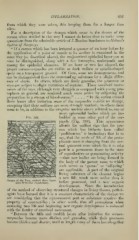Page 687 - My FlipBook
P. 687
:
INFLAMMA TION. 697
from which they were taken, this keeping them for a longer time
alive.
For a description of the changes which occur in the tissues of the
cornea when studied in this way I cannot do better than to make some
quotations from the admirable article of J. Burdon Sanderson m Holmes's
Hystem of Surgery
" If a cornea which has been irritated a quarter of an hour before by
the application of a point of caustic to its surface is examined in the
same way (as described above), the conjunctival epithelial layer can at
once be distinguished, along with a few leucocytes, underneath and
among the epithelial elements. If an hour or two has elapsed, the
proper cornea-corpuscles are visible as dark stellate or spindle-shaped
spots on a transparent ground. Of these, some are homogeneous, and
can be distinguished from the surrounding substance by a slight differ-
ence of shade. In others, which are finely granular, the processes or
rays are subject to slight variations of contour. These amoeboid move-
ments of the rays, although very sluggish as compared with young pro-
toplasm in general, are rendered much more active by subjecting the
preparation to a stream of blood-serum." . . . . " lu the cornea excised
three hours after irritation some of the corpuscles exhibit no change,
excepting that their outlines are more strongly marked ; in others there
seem to be, in addition to the irregular nucleus above referred to, one or
more spheroidal bodies which are im-
Fig bedded in some other ])art of the cor-
puscle (Fig. 388). This appearance
affords the earliest sign that the pro-
cess which has hitherto been called
'proliferation' is beginning; that is to
say, that the mode of life of the proto-
plasmic mass is changing from the nor-
mal quiescent state which fits it to take
part in a permanent tissue to the state
of reproductive or germinating activity
—that new bodies are being formed in
the body of the parent mass, to A\hich
such terms as 'germs' or 'offspring'
are applicable. A part of the original
livino; substance of the element begins
a new life, much more active than it
Cornea of the Frog, excised three hours before possessed, and a new organic
after irritation (Sanderson).
development. Since the introduction
of the method of observing structural changes in living tissues, pathol-
ogists have learned that it is a constant characteristic of the change we
are considering that the rejuvenescent part or substance acquires the
property of contractility ; in other words, that all protoplasm when
assuming new life and beginning new organic development is endowed
with the faculty of amoeboid movement.
" Between the fifth and twelfth hours after irritation the cornea-
corpuscles become more distinct and granular, while tlieir ]>rocesses
become thicker and shorter, until at length many of them lose altogether
INFLAMMA TION. 697
from which they were taken, this keeping them for a longer time
alive.
For a description of the changes which occur in the tissues of the
cornea when studied in this way I cannot do better than to make some
quotations from the admirable article of J. Burdon Sanderson m Holmes's
Hystem of Surgery
" If a cornea which has been irritated a quarter of an hour before by
the application of a point of caustic to its surface is examined in the
same way (as described above), the conjunctival epithelial layer can at
once be distinguished, along with a few leucocytes, underneath and
among the epithelial elements. If an hour or two has elapsed, the
proper cornea-corpuscles are visible as dark stellate or spindle-shaped
spots on a transparent ground. Of these, some are homogeneous, and
can be distinguished from the surrounding substance by a slight differ-
ence of shade. In others, which are finely granular, the processes or
rays are subject to slight variations of contour. These amoeboid move-
ments of the rays, although very sluggish as compared with young pro-
toplasm in general, are rendered much more active by subjecting the
preparation to a stream of blood-serum." . . . . " lu the cornea excised
three hours after irritation some of the corpuscles exhibit no change,
excepting that their outlines are more strongly marked ; in others there
seem to be, in addition to the irregular nucleus above referred to, one or
more spheroidal bodies which are im-
Fig bedded in some other ])art of the cor-
puscle (Fig. 388). This appearance
affords the earliest sign that the pro-
cess which has hitherto been called
'proliferation' is beginning; that is to
say, that the mode of life of the proto-
plasmic mass is changing from the nor-
mal quiescent state which fits it to take
part in a permanent tissue to the state
of reproductive or germinating activity
—that new bodies are being formed in
the body of the parent mass, to A\hich
such terms as 'germs' or 'offspring'
are applicable. A part of the original
livino; substance of the element begins
a new life, much more active than it
Cornea of the Frog, excised three hours before possessed, and a new organic
after irritation (Sanderson).
development. Since the introduction
of the method of observing structural changes in living tissues, pathol-
ogists have learned that it is a constant characteristic of the change we
are considering that the rejuvenescent part or substance acquires the
property of contractility ; in other words, that all protoplasm when
assuming new life and beginning new organic development is endowed
with the faculty of amoeboid movement.
" Between the fifth and twelfth hours after irritation the cornea-
corpuscles become more distinct and granular, while tlieir ]>rocesses
become thicker and shorter, until at length many of them lose altogether


